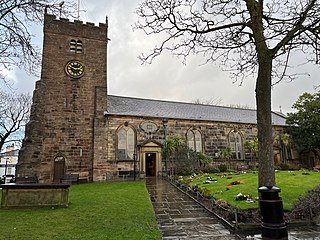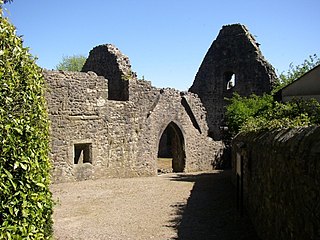This is a list of Grade I listed buildings in Lancashire, England.
St Oswald's Vicarage is on Parkgate Road, Chester, Cheshire, England. It is recorded in the National Heritage List for England as a designated Grade II listed building.

St Oswald's Church is in the village of Warton, Lancashire, England. It is an active Anglican parish church in the deanery of Tunstall, the archdeaconry of Lancaster, and the diocese of Blackburn. Its benefice is united with those of St Mary, Borwick and St John the Evangelist, Yealand Conyers. The church is recorded in the National Heritage List for England as a designated Grade II listed building. The ruined remains of the medieval rectory survive next to the present vicarage to the west of the church.

Poulton-le-Fylde is a market town in the Wyre district of Lancashire, England, situated on a coastal plain called the Fylde. There are 16 buildings and structures in the town which have been listed by the Secretary of State for Culture, Olympics, Media and Sport as being of special architectural, historical or cultural significance. One is classified as Grade II*, and the rest as Grade II; Poulton-le-Fylde has no Grade I listed buildings. The Grade II* designation is for St Chad's Church. There is written evidence of a church on the site since 1094, although it may have been built earlier. It became the Anglican parish church at the time of the Reformation and was largely rebuilt in the 18th century.

St Cuthbert's is an Anglican church in Lytham, Lancashire, England. It was built 1834–1835, replacing a previous church on the same site. It is an active parish church in the Diocese of Blackburn. Since 1971 it has been designated a Grade II* listed building.

St Oswald's Church is an Anglican church in Preesall, a town on the Fylde coastal plain in Lancashire, England. It is an active parish church in the diocese of Blackburn and the archdeaconry of Lancaster. It was built 1896–1898, designed by Hubert Austin, and is recorded in the National Heritage List for England as a designated Grade II listed building.

The Old Rectory is a ruin of a former rectory in the village of Warton, near Lancaster, Lancashire, England. Owned by English Heritage, it has been designated a Scheduled Ancient Monument and Grade I listed building.

St Benedict's Church, Bordesley is a Church of England parish church in Hob Moor Road, Bordesley, West Midlands, England, about 2+1⁄2 miles (4 km) east of Birmingham city centre. It is an early 20th-century church in Byzantine Revival style and is Grade II listed.
Melling-with-Wrayton is a civil parish in Lancaster, Lancashire, England. It contains 22 listed buildings that are recorded in the National Heritage List for England. Of these, one is listed at Grade I, the highest of the three grades, one is at Grade II*, the middle grade, and the others are at Grade II, the lowest grade. The parish contains the village of Melling and the hamlet of Wrayton, and is otherwise rural. Most of the listed buildings are houses, farmhouses and associated structures. The others include a church and associated structures, and two milestones.
Tunstall is a civil parish in Lancaster, Lancashire, England. It contains eight listed buildings that are recorded in the National Heritage List for England. Of these, one is listed at Grade I, the highest of the three grades, and the others are at Grade II, the lowest grade. The parish contains the village of Tunstall, and is otherwise rural. The listed buildings consist of houses, a church, a sundial base, and a milestone.
Warton is a civil parish in Lancaster, Lancashire, England. It contains 29 listed buildings that are recorded in the National Heritage List for England. Of these, two are listed at Grade I, the highest of the three grades, and the others are at Grade II, the lowest grade. The parish contains the village of Warton and surrounding countryside. Most of the listed buildings are houses or farmhouses, the majority being on Main Street in the village. The Lancaster Canal runs through the parish, and a flight of locks is listed. The other listed buildings include a ruined rectory, a church, a public house, a milestone, and a disused limekiln.

St John the Evangelist's Church is in Church Lane, Yealand Conyers, Lancashire, England. It is an active Anglican parish church in the diocese of Blackburn. The church was built in 1838, extended in 1861 and again in 1882. It is constructed mainly in limestone, and consists of a nave, a north aisle, a chancel and a west tower. Inside is a west gallery and stained glass by Shrigley and Hunt. The church holds services on Sundays and Wednesdays. It is recorded in the National Heritage List for England as a designated Grade II listed building.
Goldshaw Booth is a civil parish in Pendle, Lancashire, England. It contains 14 listed buildings that are recorded in the National Heritage List for England. Of these, two are at Grade II*, the middle grade, and the others are at Grade II, the lowest grade. The parish contains the village of Newchurch in Pendle and is otherwise rural. Almost all the listed buildings in the parish are houses, farmhouses, farm buildings, and associated structures. The other listed buildings are a church and two memorials in the churchyard.
Wiswell is a civil parish in Ribble Valley, Lancashire, England. It contains seven listed buildings that are recorded in the National Heritage List for England. Of these, one is listed at Grade I, the highest of the three grades, and the others are at Grade II, the lowest grade. The parish contains the small village of Wiswell, and is otherwise rural. The listed buildings consist of houses, farmhouses, a barn, and a medieval wayside cross.
Scarisbrick is a civil parish in the West Lancashire district and borough of Lancashire, England. It contains 32 buildings and structures that are recorded in the National Heritage List for England as designated listed buildings. Of these, one is listed at Grade I, the highest of the three grades, and the others are at Grade II, the lowest grade. The most significant building in the parish is Scarisbrick Hall which is listed at Grade I, with several associated structures being listed separately. The parish is a collective of smaller hamlets and is largely rural. Many of the listed buildings are houses, farmhouses or other agricultural buildings that have since been repurposed as dwellings, while the others include a telephone kiosk and the Roman Catholic Church of St Elizabeth.
Kirkland is a civil parish in the Wyre district of Lancashire, England. It contains 26 buildings that are recorded in the National Heritage List for England as designated listed buildings. Of these, one is listed at Grade I, the highest of the three grades, one is at Grade II*, the middle grade, and the others are at Grade II, the lowest grade. The parish contains the village of Churchtown and the surrounding countryside. The most important building in the parish is St Helen's Church, which is listed together with a number of structures in or near the churchyard. The other listed buildings include houses and cottages, a village cross, milestones, and a telephone kiosk.
Out Rawcliffe is a civil parish in the Wyre district of Lancashire, England. It contains five listed buildings that are recorded in the National Heritage List for England. All the listed buildings are designated at Grade II, the lowest of the three grades, which is applied to "buildings of national importance and special interest". The parish, which is almost completely rural, contains the small village of Out Rawcliffe. The listed buildings consist of a farmhouse, a country house, a church, a former vicarage, and an animal pound.
Preesall is a civil parish in the Wyre district of Lancashire, England. It contains six buildings that are recorded in the National Heritage List for England as designated listed buildings. Of these, one is at Grade II*, the middle grade, and the others are at Grade II, the lowest grade. The parish includes the villages of Preesall and Knott End-on-Sea and the surrounding countryside. The listed buildings comprise three houses, a former mill, and a church.
Ashton-in-Makerfield is a town in the Metropolitan Borough of Wigan, Greater Manchester, England. It contains ten listed buildings that are recorded in the National Heritage List for England. All the listed buildings are designated at Grade II, the lowest of the three grades, which is applied to "buildings of national importance and special interest". Industry, including coal mining, came to the town in the 19th century, but it is now mainly residential. The older listed buildings consist of farmhouses, a farm building, a chapel and a milestone, and the later ones are churches and associated structures, and a library.
Manchester is a city in Northwest England. The M23 postcode area of the city includes parts of the suburbs of Wythenshawe and Northenden. The postcode area contains eleven listed buildings that are recorded in the National Heritage List for England. Of these, one is listed at Grade I, the highest of the three grades, two are at Grade II*, the middle grade, and the others are at Grade II, the lowest grade. The area is almost completely residential, and the listed buildings include two former manor houses and associated structures, a former farm and outbuildings, a house, a church, and a vicarage.









